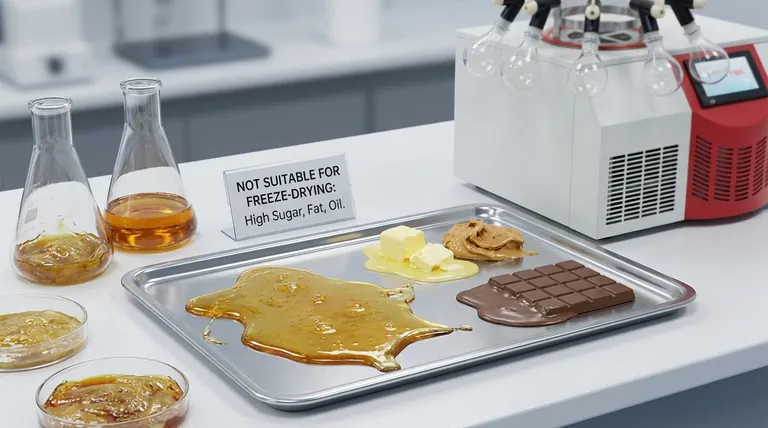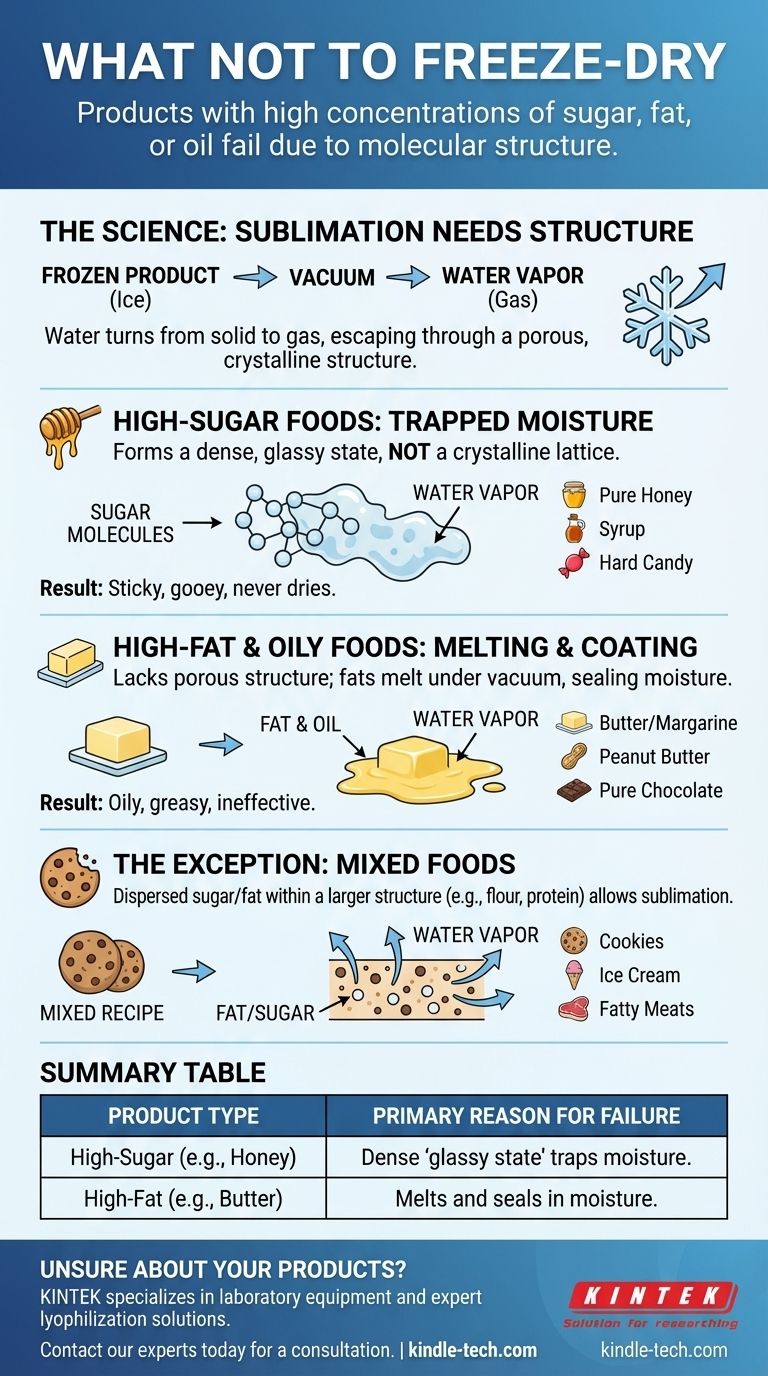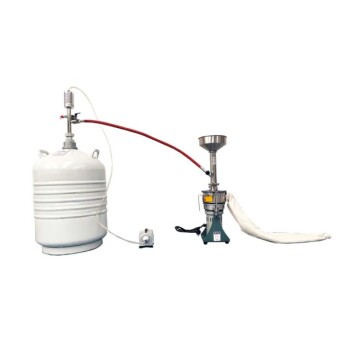In short, products with very high concentrations of sugar, fat, or oil are not suitable for freeze-drying. Items like pure honey, syrup, butter, and solid chocolate will not process correctly because their molecular structure prevents water from being effectively removed.
The core principle of freeze-drying is removing water from a solid, frozen structure through sublimation. Foods that are extremely high in sugar or fat fail because they don't create this stable, porous structure when frozen, instead trapping moisture in a dense, syrupy or oily state.

The Science of Freeze-Drying: Why Structure is Everything
The Process of Sublimation
Freeze-drying, or lyophilization, works by freezing a product and then creating a powerful vacuum.
This vacuum allows the frozen water in the product to turn directly from a solid (ice) into a gas (water vapor) without ever becoming a liquid. This process is called sublimation.
For sublimation to work, water vapor must have a clear path to escape the product. This requires the frozen item to have a rigid, porous structure, like a microscopic sponge.
Why High-Sugar Foods Fail
The Problem of a "Glassy State"
When products with extremely high sugar concentrations (like honey or syrup) are frozen, they don't form a solid crystalline lattice like typical foods.
Instead, they enter a "glassy state," which is an amorphous, non-crystalline solid. This syrupy structure is incredibly dense on a microscopic level.
Trapped Moisture
This dense, glassy state physically traps water molecules. The water vapor has no clear pathway to escape, so the sublimation process fails.
The result is a sticky, gooey, and dense product that never becomes dry and shelf-stable, often making a mess inside the freeze-dryer.
Common Examples to Avoid
- Pure honey
- Corn syrup or maple syrup
- Hard candy
- Jams and jellies with very high sugar content
Why High-Fat and Oily Foods Fail
Lack of Water and Structure
Foods that are almost pure fat or oil, like butter or peanut butter, contain very little water to begin with. The primary purpose of freeze-drying is water removal, so the process is inherently ineffective.
Furthermore, fats and oils do not freeze into a rigid, porous structure that allows the little water they do contain to escape.
The Risk of Melting and Coating
Under vacuum, the boiling point of liquids is significantly lowered. Fats and oils can melt during the freeze-drying cycle.
This melted oil can coat the surface of the food, sealing in any remaining moisture. It can also contaminate the freeze-dryer chamber and pump, leading to difficult cleanup and potential damage.
Common Examples to Avoid
- Butter or margarine
- Peanut butter
- Pure chocolate (due to high fat and sugar)
- Mayonnaise
Understanding the Trade-offs: It's About Concentration
The "Gray Area" of Mixed Foods
The key principle is concentration. Very few foods are unsuitable when they are part of a larger, mixed recipe.
For example, you cannot freeze-dry a bar of chocolate, but you can successfully freeze-dry a chocolate chip cookie or chocolate ice cream.
How Structure Provides Support
In a cookie or ice cream, the fat and sugar are dispersed within a larger structure of flour, eggs, or dairy. This structure provides the necessary porous framework for sublimation to occur, allowing the food to dry out properly.
The same applies to fatty meats. The lean muscle will dry perfectly, while the pure fat sections may remain greasy or chewy.
How to Determine if Your Product Will Work
Before committing to a large batch, it's critical to assess the primary composition of your product.
- If your primary focus is on pure substances: Avoid anything that is almost entirely sugar, fat, or oil. If you can pour it like syrup or it melts into a pool of oil, it is likely a poor candidate.
- If your primary focus is on complex meals or ingredients: Consider the overall structure. A little fat for flavor in a stew or sugar in a baked good is perfectly acceptable and will process correctly.
- If you are unsure about a product: The best approach is always to run a small test batch. This allows you to observe the outcome without wasting a large amount of food or risking a significant mess in your equipment.
By understanding the principles of sublimation, you can accurately predict which foods will succeed and which will fail.
Summary Table:
| Product Type | Examples | Primary Reason for Failure |
|---|---|---|
| High-Sugar Foods | Pure honey, syrup, hard candy | Forms a dense 'glassy state' that traps moisture, preventing sublimation. |
| High-Fat/Oily Foods | Butter, peanut butter, pure chocolate | Lacks a porous frozen structure; fats can melt and seal in moisture. |
| Suitable Alternatives | Chocolate chip cookies, ice cream, fatty meats | Sugar/fat is dispersed within a supportive structure that allows sublimation. |
Unsure if your lab samples or food products are suitable for freeze-drying?
KINTEK specializes in laboratory equipment and consumables, providing expert solutions for your lyophilization needs. Whether you're processing sensitive biological samples or developing new food products, our expertise ensures you avoid costly failures and achieve optimal results.
Let us help you enhance your lab's efficiency and success rate. Contact our experts today for a consultation and discover the right equipment and support for your specific applications.
Visual Guide

Related Products
- Benchtop Laboratory Freeze Dryer for Lab Use
- Laboratory Sterilizer Lab Autoclave Herbal Powder Sterilization Machine for Plant
- Liquid Nitrogen Cryogenic Grinder Mill Cryomill Airflow Ultrafine Pulverizer
- Desktop Fast Laboratory Autoclave Sterilizer 35L 50L 90L for Lab Use
- Laboratory Vibratory Sieve Shaker Machine for Dry and Wet Three-Dimensional Sieving
People Also Ask
- What are some common uses of freeze drying? Preserve Delicate Materials with Precision
- What is the freeze drying or lyophilisation process? A Guide to Gentle, High-Quality Dehydration
- What role does freeze drying play in scientific research? Preserve Sample Integrity for Reliable Results
- What types of liquid samples can be processed using a laboratory freeze dryer? Preserve Your Sensitive Materials
- What is the primary function of a freeze dryer in a laboratory setting? Preserve Delicate Materials with Sublimation



















